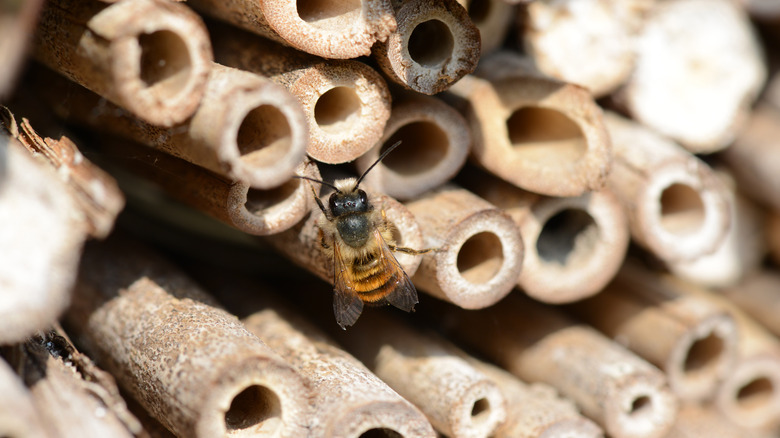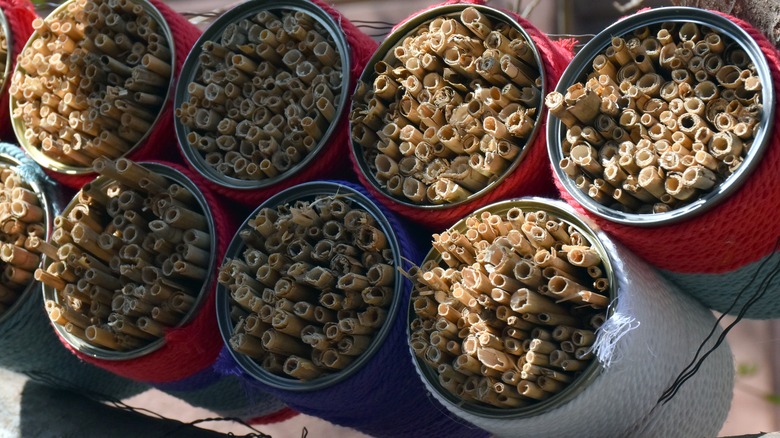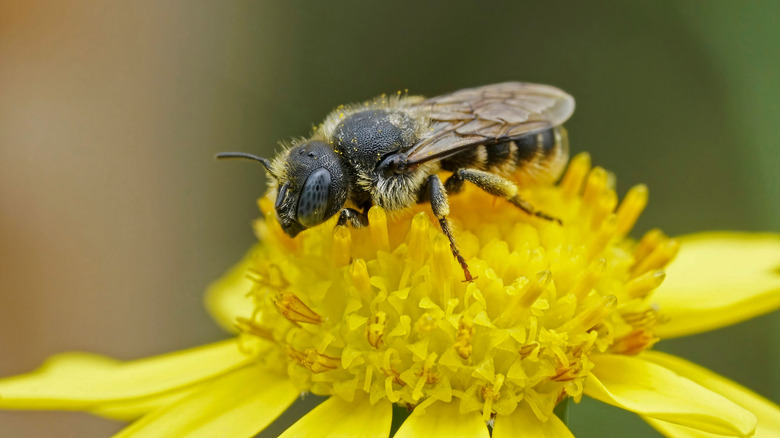Protect The Pollinators: Reuse Old Soup Cans To Make A Bee Hotel
Are you looking for a way to celebrate the start of the growing season? Then craft an upcycled habitat for essential pollinators with this DIY soup can bee hotel. Not only does this help our furry buzzing friends, but it's also a genius way to reuse leftover soup cans around the house. We understand that bees can be annoying or frightening — especially if you're allergic — but armed with some facts and craft supplies, you can walk away with a new appreciation for these buzzing creatures. This is also a great project for those with children in the home, as it's easy to do and heavy on craftwork.
According to the USDA, some scientists estimate that one of every three bites of food we take depends on help from animal pollinators, most of which are insects. You've also likely heard that everyone's favorite pollinator, the honeybee (Apis mellifera), is being threatened. While we need to be conscious about maintaining these helpful bug populations, these lesser-known solitary bees are actually more common and are powerful pollinators. With many bee species at risk from pesticide usage, urbanization, and parasites, do a small part by luring solitary bees to your yard with a home that keeps waste out of landfills!
For this DIY, you'll need at least one soup can with the lid completely removed as well as some paper, drinking straws, reused pen casings, or several pieces of bamboo for the bees to lay their eggs in and raise their young. Also, grab some non-toxic glue, paints, and a roll of twine to hang the bee hotel.
How to make a soup can bee hotel
Save hard-working solitary bees the energy of making or finding their own nests with a ready-made home assembled from reused materials. Start with a clean soup can, being careful to file down any jagged edges at the open end so the bees don't cut themselves. Add lengths of bamboo, repurposed plastic tubes, or hand-rolled paper tubes to the can until they are packed tightly enough to stay in the container. You can create paper tubes by rolling sheets around a pencil — and you earn extra green points by repurposing paper that's printed with non-toxic inks. If you're not sure the paper rolls will stay in without rolling around, you can tightly pack them inside empty toilet paper rolls and then stuff the rolls into your bee house.
Now, get out the paintbrushes and unleash your creativity by decorating the cans. Blue, purple, and violet colors have been shown to be most successful at attracting bees. Once the painted cans are dry, cut a length of twine to hang the bee house. Wrap the twine several times around the circumference of the can, spacing the wraps over the length of the can to help maintain balance while it hangs. Secure the twine with a bit of non-toxic glue, and tie it around a tree branch, fence post, or a hook with some flowers available nearby. There are so many benefits of having a bee house in your yard with this kid-friendly upcycling project.
Why do we want solitary bees as neighbors?
We tend to forget about pollinators other than honeybees, but solitary bees make up around 90% of the bee species found in North America. Solitary bees are agricultural powerhouses; their species number in the hundreds, and they pollinate many plant species. However, their survival is at risk due to habitat loss, meaning they are losing their nesting spaces and feeding grounds. Without pollinators, our ecosystems will lose biodiversity, put crops and vegetation at risk, and become more vulnerable to invasive species.
Soup can bee hotels are ideal for solitary mason or leafcutter bees and won't appeal to honeybees, since those social insects build their own nests in colonies rather than solo. If you suffer from allergies to bee stings, you can relax when solitary bees are around. Many species are stingless, and most are less aggressive and with less potent venom than other bee species on account of not having a hive and a queen to defend.
If you've set up your bee condo but are impatient and want bees ASAP, fear not. One way you can draw solitary bees to their new space is by creating an in-garden watering station for your local bees. Also, make sure to hang the hotel near flowers and other plants, as solitary bees don't travel as far as honey bees to pollinate. If you're a bee enthusiast, check out some more ways to bring more bees to your yard and garden.


